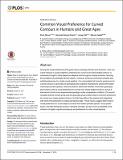Files in this item
Common visual preference for curved contours in humans and great apes
Item metadata
| dc.contributor.author | Munar, Enric | |
| dc.contributor.author | Gomez-Puerto, Gerardo | |
| dc.contributor.author | Call, Josep | |
| dc.contributor.author | Nadal, Marcos | |
| dc.date.accessioned | 2016-02-10T16:40:02Z | |
| dc.date.available | 2016-02-10T16:40:02Z | |
| dc.date.issued | 2015-11-11 | |
| dc.identifier | 240324757 | |
| dc.identifier | 9758afab-5f23-41f7-802b-b0e096be6358 | |
| dc.identifier | 000364433100020 | |
| dc.identifier | 84955500879 | |
| dc.identifier | 000364433100020 | |
| dc.identifier.citation | Munar , E , Gomez-Puerto , G , Call , J & Nadal , M 2015 , ' Common visual preference for curved contours in humans and great apes ' , PLoS One , vol. 10 , no. 11 , e0141106 . https://doi.org/10.1371/journal.pone.0141106 | en |
| dc.identifier.issn | 1932-6203 | |
| dc.identifier.other | ORCID: /0000-0002-8597-8336/work/37477881 | |
| dc.identifier.uri | https://hdl.handle.net/10023/8195 | |
| dc.description | This study was funded by research grants FFI2010-20759 and FFI2013-43270-P from the Spanish Government Ministerio de Economía y Competitividad. Gerardo Gomez-Puerto was supported by the grant BES-2011-047441. | en |
| dc.description.abstract | Among the visual preferences that guide many everyday activities and decisions, from consumer choices to social judgment, preference for curved over sharp-angled contours is commonly thought to have played an adaptive role throughout human evolution, favoring the avoidance of potentially harmful objects. However, because nonhuman primates also exhibit preferences for certain visual qualities, it is conceivable that humans' preference for curved contours is grounded on perceptual and cognitive mechanisms shared with extant nonhuman primate species. Here we aimed to determine whether nonhuman great apes and humans share a visual preference for curved over sharp-angled contours using a 2-alternative forced choice experimental paradigm under comparable conditions. Our results revealed that the human group and the great ape group indeed share a common preference for curved over sharp-angled contours, but that they differ in the manner and magnitude with which this preference is expressed behaviorally. These results suggest that humans' visual preference for curved objects evolved from earlier primate species' visual preferences, and that during this process it became stronger, but also more susceptible to the influence of higher cognitive processes and preference for other visual features. | |
| dc.format.extent | 15 | |
| dc.format.extent | 684062 | |
| dc.language.iso | eng | |
| dc.relation.ispartof | PLoS One | en |
| dc.subject | Chimpanzees pan-troglodytes | en |
| dc.subject | Top-down facilitation | en |
| dc.subject | Homo-sapiens | en |
| dc.subject | Perception | en |
| dc.subject | Recognition | en |
| dc.subject | Monkeys | en |
| dc.subject | Color | en |
| dc.subject | Attractiveness | en |
| dc.subject | Aesthetics | en |
| dc.subject | Cognition | en |
| dc.subject | BF Psychology | en |
| dc.subject | DAS | en |
| dc.subject.lcc | BF | en |
| dc.title | Common visual preference for curved contours in humans and great apes | en |
| dc.type | Journal article | en |
| dc.contributor.institution | University of St Andrews. School of Psychology and Neuroscience | en |
| dc.contributor.institution | University of St Andrews. Centre for Social Learning & Cognitive Evolution | en |
| dc.identifier.doi | https://doi.org/10.1371/journal.pone.0141106 | |
| dc.description.status | Peer reviewed | en |
This item appears in the following Collection(s)
Items in the St Andrews Research Repository are protected by copyright, with all rights reserved, unless otherwise indicated.

